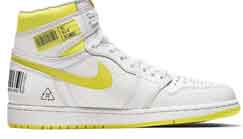Below are three of the top stories in automated data collection, RFID and the Internet of Things in recent weeks.
Apparel Magazine's Annual RFID Review
He are some highlights we thought were worth noting:
Consumers are quite interested in BOPIS — but not only for the reason you might guess. A January 2019 NRF study of consumers who had used BOPIS listed "the desire to avoid paying shipping costs" as the top reason for choosing BOPIS. 64% of respondents listed it as a motivator. By contrast, "needed items right away" ranked a distant second. It was cited by only 34% of respondents.
Supply Chain Digest Says... |
 |
| The new the Air Jordan 1 Retro High OG shoe was somehow inspired by Nike's own shipping department. |
 |
What do you say? |
| Click here to send us your comments |
 |
| Click here to see reader feedback |
|
|
Many retailers are reluctant to add BOPIS until they have improved their inventory accuracy and prepared their stores to handle this new service – and RFID can play an essential role there, as Target and others have articulated.
Along that same line, during an earnings call in May 2019 the CFO of L Brands (the parent company of Victoria's Secret) mentioned that the company is introducing RFID in its stores to improve inventory accuracy and inventory visibility. He cited this as a precursor to the company's introduction of BOPIS. More recently, the company COO announced that about 1,100 of the company's stores are slated to begin using RFID by summer 2020, with almost 350 receiving these capabilities by the end of 2019.
The magazine also said that it believes Walmart will be using RFID extensively in its stores by summer 2020.
"It's no secret that Walmart aims to offer excellent value and makes its clothing quite affordable. It's also no secret that adding RFID to a label only costs about five or six cents," the magazine said.
The upshot? It is now harder than ever for any retailer to contend that RFID is too expensive. If Walmart can find a solid business case, your company can too, the magazine says.
The world's largest athletic brands are all "in the RFID game." Nike, adidas and Under Armour have each begun using RFID in their stores and supply chains. All three have global "source tagging" programs in place in apparel, footwear and other categories. Smaller athletic brands have similar programs underway.
The world's largest sporting goods operator is Decathlon. 100% of its merchandise has an RFID tag, and 100% of its stores use RFID. Often called "the IKEA of Sporting Goods," its mission is to make quality sporting goods affordable to all. It designs, produces and sells a wide range of apparel, footwear and equipment. Decathlon has now dipped its toe in the US market, opening its first superstore in 2019 in California.
(See More Below)
|
CATEGORY SPONSOR: SOFTEON |
|
|
| |
|
|
Finally, while Macy's continues a fairly aggressive plan for full RFID enablement, most mid-market department stores in North America have not felt any urgency to race forward with RFID, the magazine adds.
Smart Glass Makers Continue to Struggle
Daqri, a leading smart glasses company founded in 2010, recently announced that it would shut down its headquarters by the end of September. The augmented reality (AR) company focused on producing smart glasses along with its complementary software, Worksense, intending to integrate these solutions into the industrial workforce.
The failure wasn't for lack of an ability to raise money. Daqri received $275 million from investors since its founding in 2010, including $260 million in 2017 alone.
But the smart glass market just is not developing in industrial/supply chain sectors. Smart glass companies Meta and ODG have also gone under.
As a result, "Eyeballs are now squarely focused on Microsoft's Hololens 2, Magic Leap and the Google Glass reboot to determine their path to commercialization," say the analysts at VDC Research.
One application that seems very viable is order picking in the warehouse using smart glasses with augmented reality, for example highlighting pick locations in the lens. But it is also very slow to develop.
Bar Codes as Fashion Statement?
 We don't quite get it, but a new Air Jordan shoe from Nikes is adorned with… bar codes? We don't quite get it, but a new Air Jordan shoe from Nikes is adorned with… bar codes?
According to the footwearnews.com, the new the Air Jordan 1 Retro High OG shoe was somehow inspired by Nike's own shipping department.
The site notes that details of the new shoe "includes bar code labels covering the heel and medial ankle collar to reinforce the first-class mail theme."
The new shoe with its bar codes can be seen in the image nearby.
Just the gift this holiday season for the shipping or fulfillment professional. Price around $160.00.
Any reaction to the stories in this week's roundup? Let us know your thoughts at the Feedback section below.
Your Comments/Feedback
|